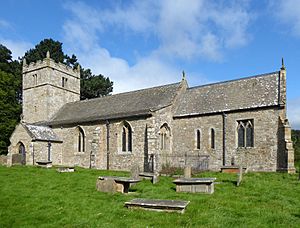Holy Trinity Church, Coverham facts for kids
Quick facts for kids Holy Trinity Church, Coverham |
|
|---|---|

Holy Trinity Church, Coverham, from the south
|
|
| Lua error in Module:Location_map at line 420: attempt to index field 'wikibase' (a nil value). | |
| OS grid reference | SE 103 863 |
| Location | Coverham, North Yorkshire |
| Country | England |
| Denomination | Anglican |
| Website | Churches Conservation Trust |
| Architecture | |
| Functional status | Redundant |
| Heritage designation | Grade II* |
| Designated | 13 February 1967 |
| Architectural type | Church |
| Style | Gothic |
| Groundbreaking | 13th century |
| Specifications | |
| Materials | Stone, stone slate roofs |
Holy Trinity Church is an old Anglican church in the small village of Coverham, located in North Yorkshire, England. It is no longer used for regular church services, which is why it is called a redundant church. This historic building is protected as a Grade II* listed building. This means it is a very important building that needs to be preserved. The Churches Conservation Trust takes care of the church today. Holy Trinity Church stands close to the old ruins of Coverham Abbey, which was once a monastery. It is also near the River Cover.
Contents
History of the Church
The oldest parts of Holy Trinity Church were built in the 13th century. This includes the main part of the church, called the nave, and the south wall of the chancel. The chancel is the area around the altar. It is believed that the south aisle, which is a side section of the church, was added in the 14th century. The tall tower at the west end of the church was built in the 15th century.
Over the years, the church has been repaired and updated. Major restorations happened in 1854 and again in 1878. These were times when the church was carefully repaired and improved. Holy Trinity Church stopped being used for regular services on September 1, 1985. It was then officially handed over to the Churches Conservation Trust on June 10, 1987.
Church Design and Features
Outside the Church
Holy Trinity Church is built from stone rubble, which means it uses rough, unshaped stones. Its roofs are made of stone slates. The church has a main nave with a side section called a south aisle. There is also a small porch on the south side. The chancel has a small room called a vestry on its north side.
The church has a tall tower at its west end. This tower has three levels and strong diagonal buttresses that support it. On the lowest level of the tower, there is a window with three sections. The middle level has a small opening on the south side for light. The top level has two-section bell openings on each side. At the very top, the tower has a parapet with a battlemented design, like a castle wall. There are also decorative crocketted finials at the corners.
The east window in the chancel has three sections and is in the Perpendicular style. This style is known for its tall, narrow windows. On the south wall of the chancel, there are two lancet windows, which are tall, narrow windows with pointed tops. There is also a square-headed window with two sections. The north wall of the nave has four pointed windows, each with two sections. The south wall of the aisle has three pointed windows, also with two sections, and the porch. The east window in the aisle is round-headed and has three sections. You can see crosses on the pointed tops, called gables, of the nave, chancel, and porch. Above the south doorway, there is a stone lintel that was once part of an Anglo-Saxon cross.
Inside the Church
Inside Holy Trinity Church, you will find a four-bay arcade. This means there are four sections of arches. These arches have pointed tops and are supported by eight-sided columns. These columns are quite simple, as they do not have bases or decorative tops, called capitals.
In the south wall of the chancel, there is an ogee-headed piscina. A piscina is a small basin used for washing sacred vessels. There is also a simpler piscina in the wall of the south aisle. The floor of the church is covered with Victorian encaustic tiles. These are decorative tiles with patterns baked into them.
Some windows in the south aisle have small shields made of painted glass. These might be from the medieval period. The church has a ring of three bells. The oldest bell was made in 1632 by William Oldfield. The other two bells were made in 1770 by Pack and Chapman at the Whitechapel Bell Foundry. The church's parish registers, which record births, marriages, and deaths, began in 1707.
See also
- Grade II* listed churches in North Yorkshire (district)
- Listed buildings in Coverham with Agglethorpe
- List of churches preserved by the Churches Conservation Trust in Northern England

